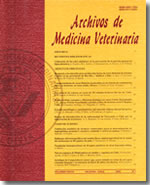Application of the EROD-H4IIE bioassay for the determination of dioxins in pork in comparison to high resolution gas chromatography coupled to high resolution mass spectrometry
Main Article Content
Abstract
The EROD-H4IIE cell bioassay is a screening method for the detection of planar halogenated hydrocarbons (PHH), it has several advantages over analytical chemistry like speed, simplicity, accuracy, high sensitivity and low cost which makes it a valuable bioassay for biomonitoring studies. It has been successfully used as screening method for the detection of dioxins and furans (PCDD/Fs) in meat from broiler chicken. The aim of this study was to detect PCDD/Fs in pork, by using both the bioassay and the high resolution gas chromatography/high resolution mass spectrometry (HRGC/ HRMS). 59 composite samples of pork chuck loin were taken at a slaughtering plant of 6 Chilean production facilities between 2004 and 2007, with one sample being taken in 2011. Mean concentrations of PCDD/Fs obtained by HRGC/HRMS ranged between 0.22 and 0.34 pg WHO-TEQ/g fat. The maximum was 0.71 pg WHO-TEQ/g fat. The average value of the congeners was 0.1 pg WHO-TEQ fat-2,3,4,7,8-PeCDF (between 0.03 and 0.28 pg/g fat). Therefore, the samples did not exceed the maximum allowed by national and international legislation. When comparing the results obtained with the two methods, 36 out of 59 sample results were overestimated by the bioassay, while 19 were underestimated and 4 were similar. 15 samples exceeded 1 pg/g TCDD-EQ tissue and only 5 exceeded 2 pg TCDD-EQ/g tissue. It was not possible to establish an equivalence between EROD-H4IIE and HRGC/ HRMS for the detection of PCDD/Fs in pork since there was not a significant association between variables (r = -0.142, P ≥ 0.2840).

